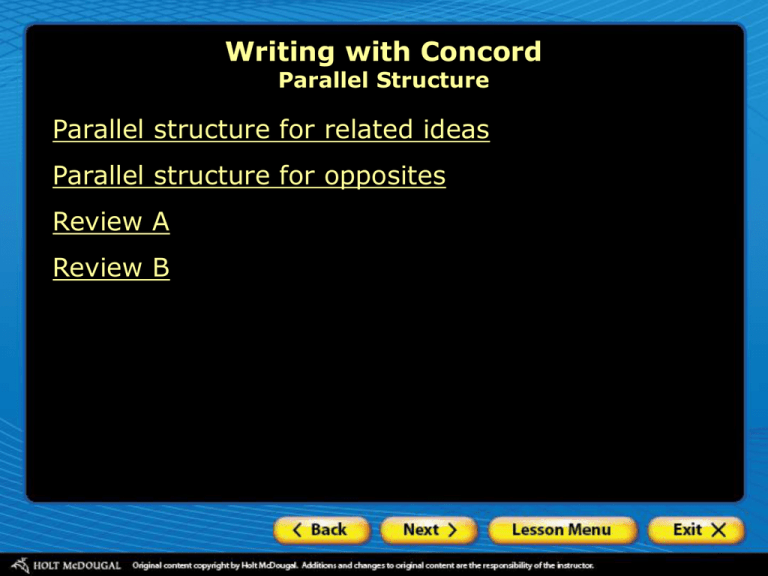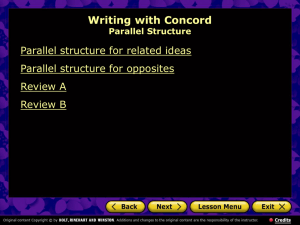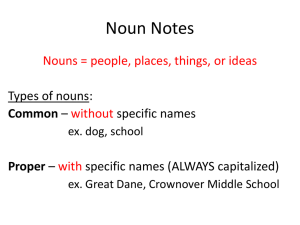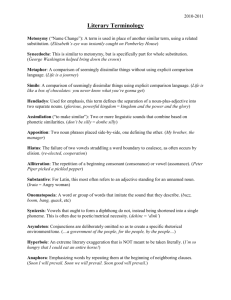Parallel Structure in Writing: Concord & Rhetoric
advertisement

Writing with Concord Parallel Structure Parallel structure for related ideas Parallel structure for opposites Review A Review B Parallel structure for related ideas Expressing related ideas in similar forms keeps writing on track. Like railroad tracks, these similar forms are said to be parallel. Parallel structure is the arrangement of corresponding parts of a sentence or group of sentences in similar grammatical forms. Parallel structure for related ideas Some of the greatest speakers and writers have used parallel structure to make their thoughts memorable. Thomas Jefferson ended the Declaration of Independence with this memorable clause: [W]e mutually pledge to each other our our lives, lives, our fortunes, our fortunes, and and our oursacred sacredhonor. honor. Note the parallel grammatical forms our + noun The repetition of the key word our adds to the sense of order and purpose in the passage. Parallel structure for related ideas Parallel structure can be used to connect single words, phrases, clauses, or even entire sentences. Here General Douglas MacArthur uses three strong nouns and three noun clauses in his farewell speech to the cadets at West Point. Duty, honor, country—those three hallowed words reverently dictate what you ought to be, what you can be, and what you will be. nouns noun clauses Parallel structure for related ideas Parallel structure is often seen in a series of three items. In his speech “I Have a Dream,” Martin Luther King, Jr., proclaims So let freedom ring from the prodigious hilltops of New Hampshire. Let freedom ring from the mighty mountains of New York. Let freedom ring from the heightening Alleghenies of Pennsylvania. King repeats the key clause “let freedom ring” three times, each instance followed by a prepositional phrase. Each phrase also contains parallel elements: from the + adjective + noun + of + name of state Parallel structure for opposites Another technique of rhetoric is to express opposites in parallel structures. Abraham Lincoln used parallel structure to express opposites in his second inaugural address: With malice toward none, with charity for all with + contrasting nouns + preposition + contrasting pronouns Parallel structure for opposites Here Winston Churchill expresses the contrast between two systems of government by using parallel structure. The inherent vice of capitalism is the unequal sharing of blessings; the inherent virtue of socialism is the equal sharing of miseries. the inherent + contrasting nouns + of + noun the + contrasting adjectives + sharing of + contrasting nouns How does the use of parallel structure bring out the contrast that Churchill is making? Parallel structure for opposites One special kind of parallel structure that orators use to relate opposites is called chiasmus. This technique gets its name from the Greek letter chi, which looks like an X. ΦΧΨΩ Like an X, chiasmus involves making two statements that “cross,” as in this sentence from John F. Kennedy’s inaugural address:A B Let us never negotiate out of fear, B A but let us never fear to negotiate. Parallel structure for opposites One of the most famous examples of chiasmus in American rhetoric comes from the same speech. Ask not what your country can do for you, ask what you can do for your country. Notice the parallel structure that makes this contrast possible. Both halves of the sentence are parallel and contain noun clauses that are also parallel. ask + noun clause what + subject + can do + prepositional phrase starting with for Parallel structure On Your Own The following sentences contain words that are not parallel in form. Revise each sentence to create parallel structure. 1. Jen completed the test quickly, but her work was incorrect. 2. Both nations agreed to stop fighting, and they are now pursuing peace. 3. If we act on our emotions, then our emotions will perform actions on us. 4. Optimists see the best in every situation, while pessimists are seeing what is worst. [End of Section] Review A Identify each group of parallel structures in this famous sentence from President Eisenhower’s 1961 farewell address. To all the peoples of the world, I once more give expression to America's prayerful and continuing aspiration: We pray that peoples of all faiths, all races, all nations, may have their great human needs satisfied; that those now denied opportunity shall come to enjoy it to the full; that all who yearn for freedom may experience its few spiritual blessings. Review B Write three statements contrasting your thoughts or experiences as a child with what you know or do now. Make each statement parallel in structure, and include one example of chiasmus. Review B Write three statements contrasting your thoughts or experiences as a child with what you know or do now. Make each statement parallel in structure, and include one [possible answers] example of chiasmus. 1. Then, I kept to myself. Today, I reach out to others. 2. As a child, I thought about play. As a young adult, I think about work. 3. If I did well, I expected some reward; now I am rewarded by doing well. (chiasmus) The End




